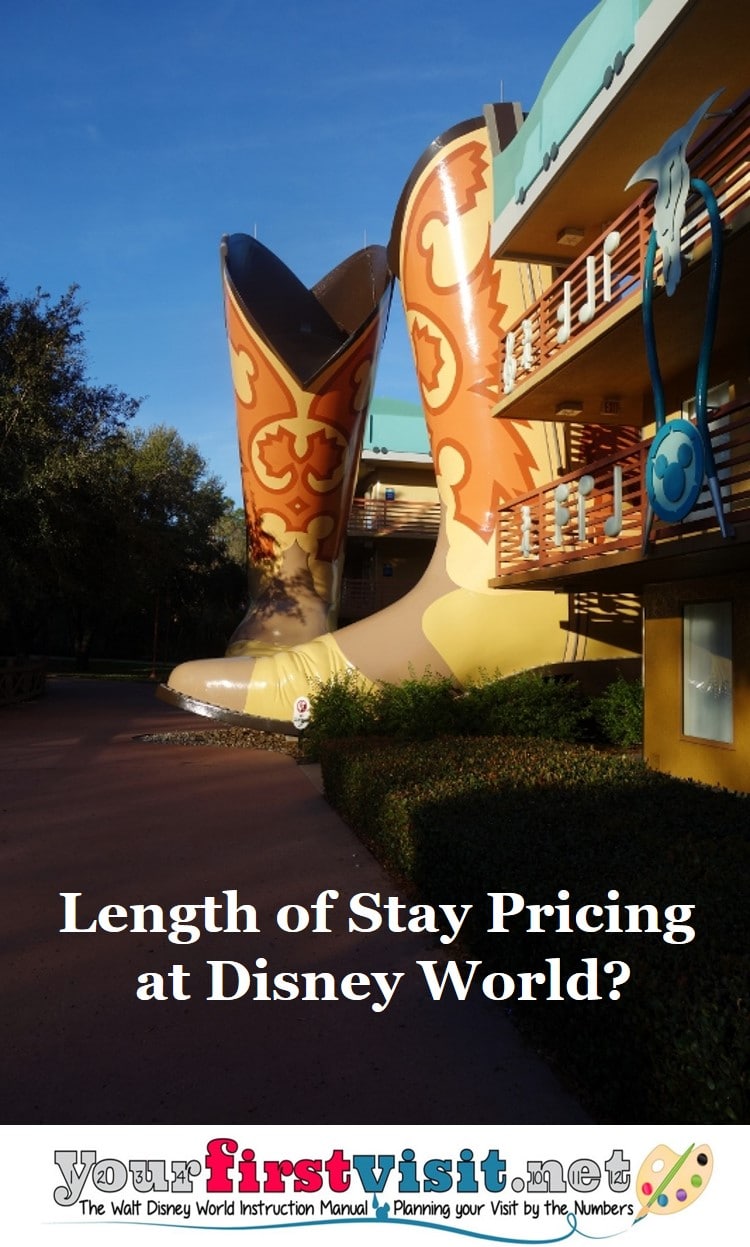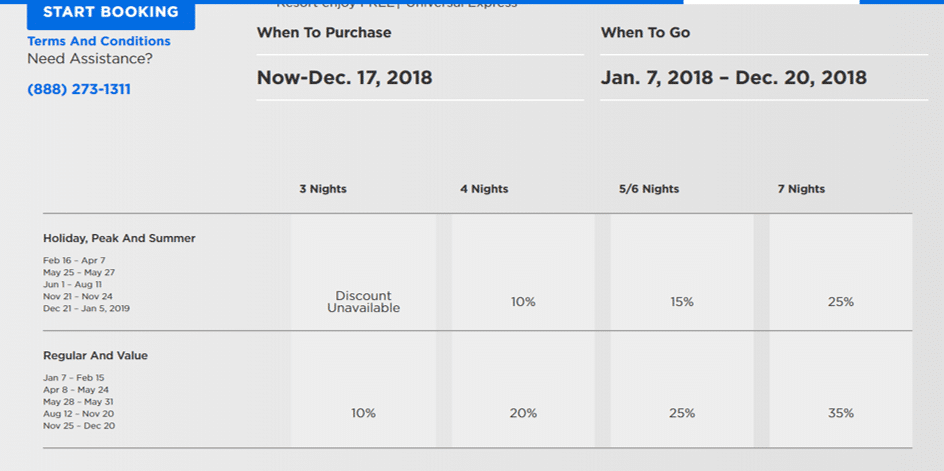Length of Stay Pricing at the Disney World Resorts?
By Dave Shute
Earlier this year Disney World announced that parking at its hotels would no longer be free for reservations booked after March 20, 2018. Only slightly less controversial than that whole poenitentia vs. metanoia thing among Luther, Erasmus, and the Catholic Church, no explanation for it has been offered other than such a parking charge is common practice.
At the end of my post on the parking matter, I’d noted that “I can think of one way in which–at least in 2019–this money may make its way back into guest pockets. I’ll publish more on this thought, which has to do with length-of-stay pricing, later.”
So this is the post on that thought. What it boils down to is that if Disney institutes length of stay discounts, it would need to make a big one-time increase in room rates to keep its overall revenue whole. The increases from parking revenue could be used to offset some of that price increase.

“We’ve got … a number of other plans as it relates to our hotel business. So we think that we’ve got room on pricing there. It’s not just about taking pricing up, it’s just about being more strategic at how we price, particularly how we manage demand and we’ve taken a number of steps there. We think we can expand length of stay …We have some nice pricing leverage with our hotels. We actually are comping nicely in hotel rates, particularly in Orlando as a for instance, but we have an opportunity to expand [length of stay].”
Bob Iger, CEO The Walt Disney Company, in the Q2 17 earnings call (May 9 2017)
Bob Iger noted about a year ago opportunities he saw to expand length of stay at the Walt Disney World hotels. One way to expand length of stay is through pricing mechanisms that reward longer stays.
Such a pricing mechanism can be as simple as giving a discount off of what would otherwise be a hotel’s rates in return for booking a stay of a certain length.
This is in effect what Universal does—it has its set of prices per night, but then takes a certain amount off of what would otherwise be the total if you book certain stay targets.
See the image—for example, on its far right, you’ll note that a seven night stay can be as much as 35% off what would otherwise be the sum of the nightly prices. That’s a big discount, in effect almost two and a half free nights (35% of seven nights= 2.45 nights).
Length of stay pricing can be meant to build a hotel’s occupancy—that is, add room nights—or to shift the current set of room nights to a group that has on average a longer length of stay.
If a hotel has plenty of rooms available and not many “typical” bookings already at the stay lengths at which the discounts kick in, then the goal would be to add room nights. High discounts might be accepted to do so, as little revenue would be lost from the few guests who already would have booked longer than the “typical” stay, and the new revenue from the extra nights would largely drop to the bottom line, since the variable costs of an extra night in a room are pretty low.
Length of stay pricing in already well-occupied hotels—as the Disney hotels are, recently reporting yet another quarter of occupancy in the 90% range—has a very different and more complicated dynamic.
Here you have different goals than increasing occupancy (because you have so little room to do so) and much less flexibility in discounting longer stays (because you are discounting many room nights that you could have sold at their regular rates).
The goal instead might be to convert the same number of room nights from shorter to longer stays, as longer stays are typically more profitable (as they spread the one-time costs of a single booking/check-in/check-out over more nights).
Or, if there is a value difference between shorter and longer stays not already captured in pricing, the goal might also be to use length of stay pricing to price shorter stays higher to extract more of the value they create. For example, Disney might be expecting Star Wars: Galaxy’s Edge, expected to open in the last quarter of 2019, to increase the demand for shorter stays from those guests coming to experience only it.
So if Disney were to institute length of stay pricing (as a typical practice, like Universal–not as a one-time deal), given high occupancies and already longer lengths of stay than Universal, I’d expect a couple of features to their program
- The deals to kick in after longer stays—for example, after five or six nights, not the three or four that Universal offers
- A lower discount curve—one that still begins at 10%, perhaps, but that doesn’t get nearly as high as 35%, other than as a temporary promotion that replaces other typical Disney World hotel deals
- A one-time price increase for the base set of undiscounted prices, so that revenue stays whole over most trip lengths.
This last point is the key one, so let me illustrate it with an example.
Let’s say Disney offers 10% off the total price of a room that would before the one-time price increase average $250 a night (in this example, thus a moderate), beginning with a six night stay.
To keep the same $1,500 revenue over the stay, average pre-discount prices would need to go up in a one-time price increase by 11% (the formula is 1/(1-discount percentage) – 1).* At a new price $278 a night, a 10% discount off the new total of $1,668 would yield the same initial $1,500 revenue.
In other words, when the hotels are essentially full and the goal is simply to lengthen average length of stay, you don’t want to give up revenue to do so—otherwise you simply lose money on the extensions.
Disney World usually announces its new hotel prices for the coming year in the summer, and while it varies across hotels, room types, and times of the year, prices commonly go up 4%+. If it used its summer 2018 pricing announcement to include for 2019 both typical price increases and also a one-time price increase meant to keep it whole after length of stay discounts, then in my example undiscounted prices would go up ~15%.
That’s a pretty big number—a headline grabbing number. How could Disney avoid some of those headlines? Well, one way to do it would be to institute a one-time price increase for something else related to the hotels, and use the revenue from it to offset the needed hotel room price increase. Like parking.
For median priced standard-view rooms, the new parking charge amounts to an average increase across 2018 (you get about the same results if you use just the last 7 or 8 months of 2018) of around 8% at the value resorts, 7% at the moderates, and 4.5% at the deluxes. So if half of guests pay for parking, then Disney World already has in hand price increases of 2.25 to 4%. It can use these already-existing one time increases to offset some of what it would otherwise want to do to 2019 prices, and perhaps (other than at the deluxes) even get the 2019 increase below 10%, which would help the headlines a bit…
Note that there are other ways to incent longer lengths of stay.
For example, since both shorter and longer Disney World stays tend to include weekends, Disney could make the price difference between weekends and weekdays even sharper than it already is.
For some time now, many, but not all, Disney World resorts have had higher prices on Friday and Saturday nights during many, but not all, price seasons.
And for the 2018 pricing year (released not long after Iger’s comments noted above) Disney also made Sunday and/or Thursday prices higher than the rest of its weekday prices at some resorts during some price seasons (gory details here).
Continuing this approach with even sharper differences between higher and lower priced nights would certainly either dis-incent and/or capture more value from shorter trips that include these higher priced nights. I’m not sure, though, that sharper differences would have much effect on lengthening stays, as—at least now—Disney does not inform you of the cost of adding a room night.
*The increase actually needs to be less than this, as those on shorter stays pay its full value. But for me to estimate how much less, I’d need data on the distribution of bookings by length of stay, which I don’t have, so I am ignoring this issue.
Follow yourfirstvisit.net on Facebook or Twitter or Pinterest!!






4 comments
Interestingly, Dave, I just had a pop-up ad on my laptop for Aulani…”stay 5 or more consecutive nights and receive up to 30% off.” I had a look and 5 night and longer stays are 25-30% off depending on view, and then the discount goes down from there for shorter stays much like the example you shared from Universal. So it looks like Disney is indeed moving in that direction! Thanks for a wonderful planning site!
Interesting, DJ!
So do you think the seasonal discounts would then disappear?
Angelique, by seasonal discount, if you mean “price seasons” then I expect those will continue. If you mean the various deals Disney World offers over the course of the year, those will continue to narrow and be hard to get, especially for lower priced rooms, until Galaxy’s Edge opens–when all bets are off.
Leave a Comment | Ask a Question | Note a Problem